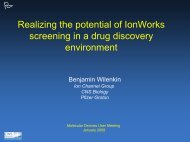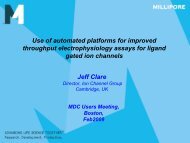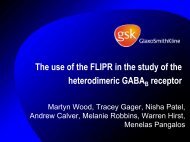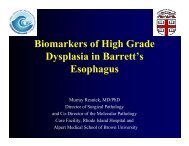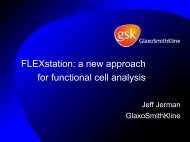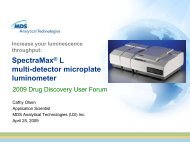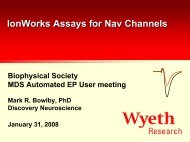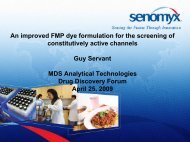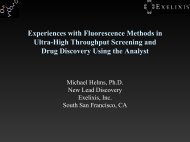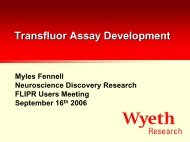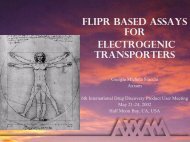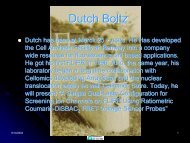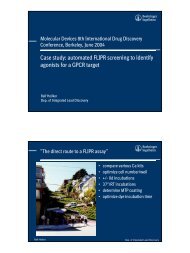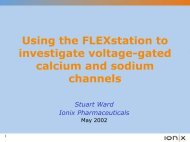1 Integrating High Throughput Electrophysiology into the Drug ...
1 Integrating High Throughput Electrophysiology into the Drug ...
1 Integrating High Throughput Electrophysiology into the Drug ...
You also want an ePaper? Increase the reach of your titles
YUMPU automatically turns print PDFs into web optimized ePapers that Google loves.
<strong>Integrating</strong> <strong>High</strong> <strong>Throughput</strong><br />
<strong>Electrophysiology</strong> <strong>into</strong> <strong>the</strong> <strong>Drug</strong><br />
Discovery Process<br />
Peter Haddock, PhD.<br />
Pfizer CNS Biology<br />
PGRD Michigan<br />
Automated <strong>Electrophysiology</strong> Users Meeting<br />
Salt Lake City<br />
February 16, 2006
Ion channel drug discovery
Pfizer Global Research and<br />
Development<br />
PGRD Ann Arbor, MI
Ion channels as drug targets<br />
Marketed drugs<br />
Excitable cells<br />
Non-excitable cells<br />
O<strong>the</strong>rs<br />
Hypertension<br />
Anxiety<br />
Pain<br />
Epilepsy<br />
Insomnia<br />
Incontinence<br />
Stroke<br />
Diabetes<br />
Autoimmune<br />
Cancer<br />
COPD<br />
Osteoporosis<br />
Allergy/asthma<br />
Ion channel<br />
targets<br />
• 30% of marketed drugs<br />
• 15 of 100 bestselling drugs<br />
• Sales $6-12 billion / year<br />
• 7 superclasses<br />
• ~400 ion channel genes<br />
• Regulate an array of physiological<br />
processes<br />
• Role in numerous disease states<br />
• Great opportunity for drug discovery<br />
– Hampered by lack of high throughput<br />
electrophysiology screening technologies
Historical approaches<br />
Receptor binding<br />
In vitro / in vivo efficacy<br />
Attrition<br />
Structure vs. activity<br />
selectivity<br />
safety<br />
Manual patch<br />
Candidate ion channel modulators
Realizing <strong>the</strong> full potential of ion<br />
channels as a viable target class<br />
selectivity<br />
Ion channel<br />
Discovery projects<br />
CV safety<br />
Requirement for quantum improvement in <strong>the</strong> throughput<br />
of electrophysiological screening platforms<br />
SAR<br />
Focused ion channel<br />
chemical libraries
Expanding throughput?
An Integrated Approach to Ion<br />
Channel <strong>Drug</strong> Discovery<br />
IDEA<br />
Attrition / SAR<br />
Characterization<br />
DRUG<br />
1000’s 100’s 10’s 1’s
Automated <strong>Electrophysiology</strong> Systems<br />
in Pfizer <strong>Drug</strong> Discovery<br />
• Assay development, data and experience<br />
– PatchXpress<br />
• hERG<br />
• >18 months<br />
– IonWorks Quattro<br />
• Nav channels<br />
• 4 months<br />
– Manual patch clamp<br />
– FLIPR/VIPR
PatchXpress<br />
hERG<br />
Nav<br />
Cav
Key variables<br />
• Cell type success<br />
– RBL > CHO > HEK<br />
• Cell husbandry and preparation<br />
– Rigorous attention to detail – gentle approach to cell harvest<br />
– 60-70% confluence<br />
– Short trypsinization period<br />
– 30 min rest period prior to use<br />
– Cell tituration prior to chip loading<br />
• Patch settings<br />
– Suction, settling time, Ra optimization etc.<br />
• Compound preparation<br />
– Glass vials and compound plates<br />
– Multiple drug additions<br />
– Length of addition<br />
• Dependent on compound class
Assay development<br />
Manual system<br />
Automated systems<br />
Cell line and current<br />
characterization<br />
Voltage protocols<br />
Signal/noise<br />
Clonal analysis +<br />
Data comparison<br />
with manual system<br />
Cell isolation/solutions<br />
endpoints
PatchXpress validation<br />
Transitioning hERG screening to an automated platform<br />
1. Compound potency<br />
– Manual patch ≡ PatchXpress?<br />
2. Effect of temperature?<br />
– Manual (35 o C) vs. PatchXpress (22 o C)<br />
3. Site-to-site variation<br />
– Global organization
Measuring hERG activity on PX<br />
+30mV<br />
-80mV<br />
Pseudo cardiac action potential<br />
<br />
<br />
200 pA<br />
Control<br />
dofetilide-sensitive (hERG) current<br />
500 ms<br />
Start<br />
10 µM dofetilide<br />
10µM dofetilide<br />
baseline<br />
A B C<br />
Rising drug concentrations
hERG pharmacology on PX<br />
1.5<br />
100<br />
peak hERG current (nA)<br />
1.0<br />
0.5<br />
Control<br />
[A]<br />
[B]<br />
[C]<br />
% inhibition<br />
80<br />
60<br />
40<br />
20<br />
0.0<br />
[D]<br />
10 µM dofetilide<br />
0<br />
1 10 100 1000<br />
[Compound] (µM)
Compound Potency<br />
manual vs. PatchXpress<br />
Compound<br />
Manual Rig IC 50<br />
RT (nM)<br />
PatchXpress IC 50<br />
RT (nM)<br />
Ratio IC 50<br />
PatchXpress/Manual<br />
Rig (RT)<br />
Bepridil 222 648 2.9<br />
Cisapride 40 57 1.4<br />
Citalopram 2700 2700 1.0<br />
E-4031 24 28 1.2<br />
Flecainide 1600 1600 1.0<br />
Fluoxetine 1100 1200 1.1<br />
Haloperidol 40 40 1.0<br />
Propranolol 14600 11200 0.8<br />
Quinidine 1400 1300 0.9<br />
Risperidone 375 522 1.4<br />
dl-Sotalol 354000 421000 1.2<br />
Verapamil 745 1040 1.4<br />
Mean 1.3<br />
SEM 0.2<br />
n 12<br />
PatchXpress hERG IC 50<br />
(nM, RT)<br />
1000000<br />
100000<br />
10000<br />
1000<br />
100<br />
Line of Identity<br />
10<br />
10 100 1000 10000 100000 1000000<br />
Manual hERG IC 50<br />
(nM, RT)
Effect of temperature<br />
manual vs. PatchXpress<br />
Compound<br />
Manual IC 50 (nM)<br />
(35 o C)<br />
PatchXpress IC 50<br />
(nM) (RT)<br />
Ratio<br />
RT PatchXpress / 35 o C<br />
manual IC 50<br />
1000000<br />
PF# 1 1600 996 0.62<br />
PF# 2 130 158 1.22<br />
PF# 3 240 238 0.99<br />
PF# 4 1500 2301 1.53<br />
PF# 5 1660 2217 1.34<br />
PF# 6 1230 459 0.37<br />
PF# 7 2570 2278 0.89<br />
PF# 8 2200 2513 1.14<br />
PF# 9 3700 1932 0.52<br />
PF# 10 920 831 0.90<br />
Bepridil 26 64 2.46<br />
Cisapride 15.2 28 1.84<br />
Risperidone 75 245 3.27<br />
Quinidine 850 599 0.70<br />
Manual hERG IC 50<br />
(nM, 35 o C)<br />
100000<br />
10000<br />
1000<br />
100<br />
10<br />
Line of Identity<br />
R = 0.97<br />
Mean 1.3<br />
SEM 0.2<br />
10 100 1000 10000 100000 1000000<br />
PX hERG IC 50<br />
(nM, RT)
Site-to<br />
to-site variation<br />
Compound<br />
Pfizer Site #1<br />
PatchXpress IC 50<br />
(nM)<br />
Pfizer site #2<br />
PatchXpress IC 50<br />
(nM)<br />
Cisapride 57 34<br />
Citalopram 2700 1780<br />
E-4031 28 33<br />
Flecainide 1600 902<br />
Quinidine 1300 1030<br />
dl-Sotalol 421000 526000<br />
Pfizer Site #2 hERG IC 50<br />
(nM)<br />
100000<br />
10000<br />
1000<br />
100<br />
line of identity<br />
10<br />
10 100 1000 10000 100000<br />
Pfizer Site #1 hERG IC 50<br />
(nM)
Minimizing Potency Shifts on PX<br />
• Compound solvation<br />
• Plastic vs. glass compound plates<br />
• Single vs. double compound addition<br />
Compound<br />
PX Single Addition<br />
(plastic compound plate)<br />
PX Double Addition<br />
(glass compound plate)<br />
Manual<br />
PX<br />
Single addition / manual<br />
PX<br />
Double addition / manual<br />
1 57 28 15 3.8 1.8<br />
2 120 64 26 4.6 2.5<br />
3 265 158 130 2.0 1.2<br />
4 470 238 240 2.0 1.0<br />
5 512 245 75 6.8 3.3<br />
6 988 459 1230 0.8 0.4<br />
7 1473 599 850 1.7 0.7<br />
8 1865 831 920 2.0 0.9<br />
9 2658 1932 3700 0.7 0.5<br />
10 2704 2513 2200 1.2 1.1<br />
11 2930 2278 2570 1.1 0.9<br />
12 3397 2301 1500 2.3 1.5<br />
13 4057 2217 1660 2.4 1.3<br />
14 4802 996 1600 3.0 0.6<br />
Mean 2.5 1.3<br />
SEM 0.4 0.2
PX hERG Data Analysis<br />
• Manual analysis vs. DataXpress script<br />
• ± rundown correction<br />
#<br />
Excel Analysis<br />
No RD Correction<br />
DX Analysis<br />
No RD Correction<br />
DX Analysis<br />
+ RD correction Excel / DX<br />
No Correction<br />
IC 50 Ratios<br />
Excel / DX + RD<br />
correction<br />
DX no correction /<br />
DX + RD correction<br />
1 49 55.5 49 0.9 1.0 1.1<br />
2 130 139 159 0.9 0.8 0.9<br />
3 320 426 369 0.8 0.9 1.2<br />
4 440 477 470 0.9 0.9 1.0<br />
5 460 796 732 0.6 0.6 1.1<br />
6 880 1026 981 0.9 0.9 1.1<br />
7 1600 1847 1703 0.9 0.9 1.1<br />
8 1700 1997 1865 0.9 0.9 1.1<br />
9 2200 2323 2191 1.0 1.0 1.1<br />
10 2300 2603 2658 0.9 0.9 1.0<br />
11 2400 3560 2930 0.7 0.8 1.2<br />
12 2500 3835 3354 0.7 0.7 1.1<br />
13 2600 3068 2788 0.9 0.9 1.1<br />
14 2700 3067 3166 0.8 0.9 1.0<br />
15 2800 3623 3397 0.8 0.8 1.1<br />
16 3100 3645 3452 0.9 0.9 1.1<br />
17 3100 4092 3454 0.8 0.9 1.2<br />
18 3500 4016 3910 0.9 0.9 1.0<br />
19 3900 4538 4407 0.9 0.9 1.0<br />
20 4500 5234 4802 0.9 0.9 1.1<br />
21 4800 5846 5865 0.8 0.8 1.0<br />
22 6300 8850 7515 0.7 0.8 1.2<br />
23 9900 13624 10719 0.7 0.9 1.3<br />
24 16500 19161 18386 0.9 0.9 1.0<br />
25 20800 26379 23718 0.8 0.9 1.1<br />
26 54000 83253 65869 0.7 0.8 1.3<br />
27 55400 64085 62398 0.9 0.9 1.0<br />
28 99200 103955 115277 1.0 0.9 0.9<br />
Mean 0.8 0.9 1.1<br />
SEM 0.02 0.01 0.02
PX Impact<br />
• All pre-CAN nomination hERG screening<br />
performed on PX<br />
– Global standard<br />
• Manual work reserved for post-CAN<br />
package<br />
• Progression of two ion channel discovery<br />
programs to CAN<br />
• FTE use<br />
– 1x PX vs. 5x manual rigs
PatchXpress – beyond hERG screening<br />
Cav channels<br />
Ligand-gated channels<br />
0<br />
500 µM Ni 2+ [ligand] µM 0.3 1 3 10 30 100<br />
100<br />
300<br />
500pA<br />
25ms<br />
30<br />
control
PX Issues<br />
• Compound addition can result in cell loss<br />
• relatively rapid addition<br />
• double addition protocol<br />
• Maximum success rate < 60 %<br />
• < 9 cells/chip<br />
• Absence of rapid post-acquisition data<br />
interrogation tools<br />
• Not truly HTS/PMC compatible<br />
– fills a niche
IonWorks Quattro<br />
Nav<br />
hERG
Characteristics of Nav IonWorks<br />
experiments<br />
350<br />
3.5 MΩ<br />
10<br />
300<br />
Count<br />
250<br />
200<br />
150<br />
100<br />
4.1 MΩ<br />
Peak current (nA)<br />
1<br />
0.1<br />
50<br />
0<br />
3.0 3.2 3.4 3.6 3.8 4.0 4.2 4.4 4.6 4.8 5.0<br />
Hole resistance (MΩ)<br />
0.01<br />
0 100 200 300 400 500 600 700 800<br />
Cell number
IonWorks protocol<br />
• Single hole mode<br />
• HEK-Nav cell line<br />
• P13 / 50-60 % confluence<br />
• T75 - ~10 6 cells / ml<br />
• 50/50 Trypsin/Versene<br />
• 10 min Amphotericin soak<br />
• Pre / post compound read<br />
• < 0.3 % DMSO<br />
0<br />
-90 mV<br />
-100 20 ms
Seal Quality and Quantity<br />
Seal resistance > 100 MΩ (~80 % success rate)<br />
100<br />
Inital read<br />
100<br />
Pre-compound<br />
100<br />
Post-compound<br />
300<br />
250<br />
Cell count<br />
80<br />
60<br />
40<br />
20<br />
80<br />
60<br />
40<br />
20<br />
80<br />
60<br />
40<br />
20<br />
# cells with seals >100 MΩ<br />
200<br />
150<br />
100<br />
50<br />
0<br />
0<br />
0 100 200 300 400 500<br />
0<br />
0 100 200 300 400 500<br />
0 100 200 300 400 500<br />
0<br />
initial<br />
pre-compound<br />
post-compound<br />
Seal resistance (MΩ)<br />
Suitable for transfer to PPC mode
Nav1 Pharmacology<br />
• Single pulse<br />
• Read pre/post compound<br />
• Peak amplitude filter >0.2 nA<br />
• Seal resistance filter >100 MΩ<br />
• Experiment duration 55 min<br />
0.1 nM<br />
TTX<br />
100 nM<br />
100<br />
0<br />
80<br />
2 ms<br />
0.5 nA<br />
30 nM TTX<br />
% inhibition<br />
60<br />
40<br />
IC 50<br />
= 12.7 nM<br />
control<br />
20<br />
0<br />
0.01 0.1 1 10 100 1000<br />
TTX (nM)
Nav - <strong>Drug</strong> Use-Dependency<br />
10 Hz pulse train<br />
Seal resistance > 100 MΩ (~80 % success rate)<br />
• 35 s pre-hold at Vm before pulse train<br />
• Metric to quantify amplitude of 25 th pulse<br />
– Control vs. compound<br />
% Inhibition<br />
0<br />
-25<br />
-50<br />
-75<br />
-100<br />
-125<br />
-7 -6 -5 -4 -3<br />
log [ ]
hERG - IonWorks<br />
Seal resistance > 100 MΩ (~70 % success rate)<br />
• HEK-hERG cell line<br />
• Single hole mode<br />
• 50-60 % confluence<br />
• T75 - ~10 6 cells / ml<br />
• 50/50 Trypsin/Versene<br />
• 10 min Amphotericin soak<br />
• < 0.3 % DMSO<br />
500ms<br />
0.2 nA
hERG - IonWorks<br />
800<br />
800<br />
800<br />
1<br />
count<br />
700<br />
600<br />
500<br />
400<br />
700<br />
600<br />
500<br />
400<br />
700<br />
600<br />
500<br />
400<br />
Peak hERG tail current (nA)<br />
0.1<br />
0.01<br />
1E-3<br />
300<br />
300<br />
300<br />
200<br />
100<br />
200<br />
100<br />
200<br />
100<br />
1E-4<br />
150<br />
0 200 400 600 800 1000 1200 1400 1600 1800 2000<br />
cell number<br />
0<br />
0<br />
0<br />
0 100 200 300 400 500 0 100 200 300 400 500<br />
seal resistance (MΩ)<br />
• Assay development<br />
0 100 200 300 400 500<br />
count<br />
120<br />
90<br />
60<br />
30<br />
0<br />
0 1 2 3<br />
peak hERG tail current (nA)
IonWorks Utility<br />
Advantages<br />
• Rapid SAR analysis and compound attrition<br />
– Ability to support high-speed chemistry approaches<br />
• Simple to use acquisition interface<br />
• Simple post-acquisition analysis tools<br />
• Efficient FTE use<br />
• Cost / data point<br />
Limitations<br />
• Single compound addition, no washout<br />
• No families of currents<br />
• Current – voltage relationships<br />
• Steady-state activation / inactivation<br />
• Discontinuous voltage-control<br />
• Voltage-dependent inhibitors<br />
• Not considered a hindrance relative to throughput and position in<br />
screening funnel<br />
• O<strong>the</strong>r platforms more suited to measure additional endpoints
Implications of PX and IW<br />
Quattro integration<br />
• Expanded drug discovery support<br />
– Target validation<br />
– SAR<br />
– increased colleague confidence in doability of<br />
target class within portfolio<br />
• Safety-related screening<br />
– more<br />
– earlier<br />
– significant reduction in manual rig time<br />
• reserved to address key kinetic issues
<strong>High</strong> throughput realized?<br />
# compounds tested / week / FTE<br />
2<br />
25<br />
250<br />
Significant impact on content of <strong>the</strong> discovery portfolio
Integration <strong>into</strong> a drug discovery<br />
screening funnel<br />
Idea<br />
IonWorks<br />
Manual patch<br />
- cell line selection<br />
- cell line/assay optimization<br />
- hit ID<br />
- attrition<br />
- leads<br />
SAR<br />
selectivity<br />
safety<br />
IonWorks<br />
FLIPR<br />
- lead optimization<br />
- focus on throughput<br />
Manual patch<br />
PatchXpress<br />
in vitro / in vivo efficacy<br />
Candidate drugs<br />
- extended electrophysiological<br />
characterization<br />
- candidate quality attributes
Use <strong>the</strong> Right Tool for <strong>the</strong> Job<br />
x<br />
• IonWorks and PatchXpress fill certain niches<br />
– facilitate credible prosecution of ion channels as chemistrysupported<br />
drug targets<br />
• Manual patch is not redundant<br />
– like any tool, use it for what it is designed for<br />
• Like o<strong>the</strong>r target classes, ion channels need a<br />
range of techniques to be effectively pursued
Summary<br />
• New era in ion channel drug discovery<br />
• Quantum improvement in ability to screen at<br />
capacity compatible with drug discovery<br />
• Positive impact on<br />
– Perception of ion channel project doability<br />
– New targets<br />
– RIP targets<br />
– CV safety of all target classes<br />
• Toolbox of complementary technologies now<br />
available
Acknowledgements<br />
<br />
• Ben Wilenkin<br />
• Mark Weber<br />
• Chasta Khozouie<br />
• Brandi Soldo<br />
• Bernard Fermini<br />
• David Caouette<br />
• Gareth Waldron<br />
• Kirk Schroeder<br />
• Sohiel Memarsadeghi
Questions?



